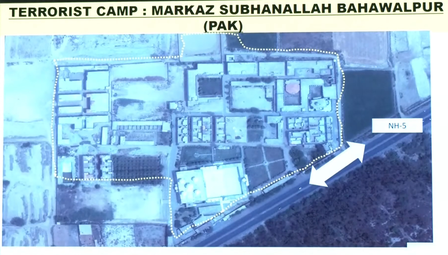
New Delhi, May 12: In a strategic series of precision strikes conducted under ‘Operation Sindoor’, the Indian Armed Forces targeted core terror infrastructures in Pakistan with the aim of delivering a direct message to groups long responsible for orchestrating terror on Indian soil.
Military sources confirmed that the strikes were concentrated on key facilities linked to Jaish-e-Mohammed (JeM) and Lashkar-e-Taiba (LeT) — two of the most dangerous and state-supported terror outfits operating out of Pakistan.
According to Indian military officials, the Bahawalpur facility, long known as the operational headquarters of Jaish-e-Mohammed, was among the first and hardest-hit targets. “Bahawalpur was high on our list, and it received one of the most potent strikes executed during the operation,” a senior official said. The choice of target underscored India’s intent to hold JeM accountable for decades of violent activities, including the first-ever suicide bombing in Jammu and Kashmir in 2000 and the 2001 Parliament attack.
Jaish-e-Mohammed, according to intelligence assessments, is a direct creation of Pakistan’s ISI. Following the 1999 hijack of Indian Airlines flight IC 814, key terrorists — including Masood Azhar and Ahmed Omar Saeed Sheikh — were released and received in Pakistan under ISI supervision. “It was under their watch that Jaish-e-Mohammed was formed, inheriting the militant infrastructure of the defunct Harkat-ul-Mujahideen,” a source noted. This deep-rooted state complicity, officials said, made it imperative to strike at the heart of JeM.
Tracing the genealogy of Pakistan-based terrorism, sources explained how Harkat-ul-Jihad al-Islami (HUJI) and Harkat-ul-Mujahideen (HUM) — veteran groups from the Afghan jihad –merged and split repeatedly, eventually giving rise to JeM. Early in the 1990s, Pakistani Punjabi fighters were deliberately inserted into Jammu and Kashmir.
“This wasn’t about supporting local discontent,” an official emphasised. “This was a deliberate state-sponsored insertion of well-trained militants to carry out brutal, high-profile attacks like Wandhama in 1998 and Chittisinghpura in 2000.”
Similarly, the Indian strikes also focused on Muzaffarabad — the long-established hub for Lashkar-e-Taiba, the group behind the 2008 Mumbai attacks and numerous other atrocities. Muzaffarabad, in Pakistan-occupied Kashmir, has been a multi-group staging ground for decades. Indian intelligence traced LeT’s origins to the Markaz-ud-Dawa-wal-Irshad, a radical centre founded by Zaki-ur-Rehman Lakhvi and other jihad veterans, including Abdullah Azzam, the ideological father of the Afghan jihad.
“Lashkar too began in Afghanistan. These fighters were later repurposed by Pakistan’s ISI to wage a proxy war in Jammu and Kashmir,” a military analyst said. “Muzaffarabad is not just symbolic — it’s functional. It houses infrastructure, training camps, and command centres.”
The Indian strikes, military sources clarified, were conducted using advanced precision weaponry, carefully avoiding civilian infrastructure but aimed at sending an unmistakable message to both terrorist groups and their state patrons. “We are no longer going after token camps. We’re hitting headquarters, leadership hubs — deep in their heartland,” the source said.
Officials also pointed out that these actions are part of a broader strategic shift — one where India is re-defining the rules of engagement. “This is part of the new normal. The cost of cross-border terrorism will not only be paid by terrorists but also by those who harbour them,” say sources.
This shift follows years of evolving tactics by Pakistan, beginning with its decision in the early 1990s to transition from Kashmiri-origin militants like Hizbul Mujahideen to more ruthless Pakistani Punjabi operatives. “When Hizbul didn’t measure up, Pakistan sent in Punjabi Muslims with Afghan combat experience to raise the brutality level. That’s when groups like JeM and LeT came to dominate the landscape,” the official said.
